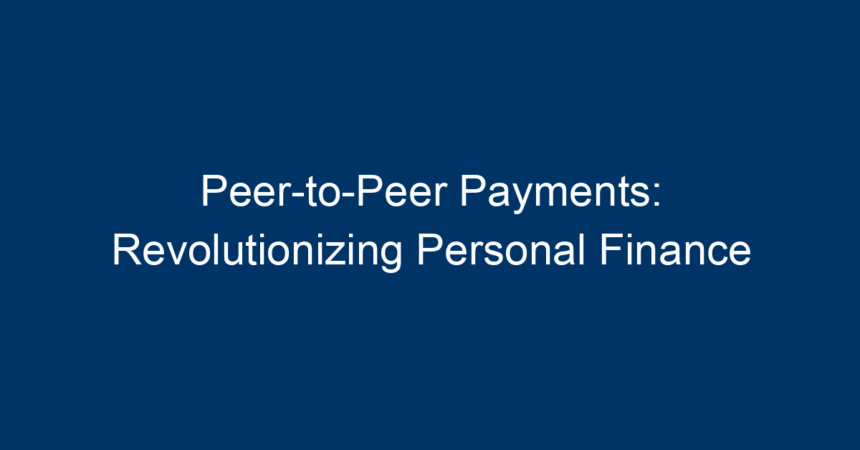In the digital age, convenience is king. One of the major developments shaping our financial landscape is the rise of peer-to-peer payments. Gone are the days when cash was king, and checks ruled the world. Today, individuals can effortlessly send and receive money through mobile apps and online platforms, making transactions simpler, faster, and more efficient. This article explores the ins and outs of peer-to-peer payments, their benefits, potential challenges, and what the future holds for this transformative technology.
What Are Peer-to-Peer Payments?
Peer-to-peer (P2P) payments refer to the direct transfer of funds between two parties without the need for a traditional financial intermediary, such as banks. This process is typically facilitated by online platforms and mobile apps, allowing users to send money instantly with just a few clicks. Services like Venmo, PayPal, Zelle, and Cash App have made P2P transactions commonplace, enabling a seamless flow of funds between friends, family, and businesses.
The Evolution of Payment Systems
Understanding the impact of peer-to-peer payments requires a brief look at the evolution of payment methods. From barter systems to coins, and then checks, the introduction of credit cards marked a significant shift in how we handle money. However, these systems often involve middlemen, leading to delays and fees.
With the advent of the internet and mobile technology, the landscape changed dramatically. Peer-to-peer payments emerged as a solution to the inefficiencies of traditional systems. By allowing users to transact directly, P2P payments have not only streamlined the process but have also given rise to a more democratized financial ecosystem.
Benefits of Peer-to-Peer Payments
1. Speed and Convenience
One of the most significant advantages of P2P payments is speed. Transactions that once took days can now be completed in seconds. Whether you’re splitting a dinner bill or paying your rent, it’s as simple as entering a recipient’s phone number or email address. This convenience is especially appealing to younger generations who are accustomed to instant gratification.
2. Lower Costs
P2P payment platforms typically charge lower fees than traditional banking systems. Many services allow users to send and receive money for free, making them an economical choice for personal transactions. This cost-effectiveness is particularly beneficial for those who need to send money across borders without incurring high transfer fees.
3. Enhanced Tracking and Record-Keeping
Most P2P platforms come equipped with features that help users track their transactions easily. Each payment is logged within the app, ensuring that you have a clear record of your financial activities. This simplification is invaluable for budgeting and financial planning, making it easier to keep track of your expenses.
4. Increased Financial Inclusion
Peer-to-peer payments have the potential to include individuals who otherwise might not have access to traditional banking services. With just a smartphone and internet connection, anyone can join the digital economy, providing vital financial services to unbanked populations globally.
Common Use Cases for Peer-to-Peer Payments
1. Social Payments
Sharing expenses with friends has never been easier. Whether it’s covering a group lunch or splitting costs for a vacation, P2P payments facilitate seamless transactions. Most platforms even allow users to add notes or emojis to their payments, making the process more social and engaging.
2. E-commerce Transactions
In addition to personal payments, businesses are leveraging P2P payment solutions for e-commerce. Companies can accept payments directly through these platforms, providing a simple checkout experience for customers. This shift not only enhances customer satisfaction but also reduces cart abandonment rates.
3. Bill Payments
Many users now rely on peer-to-peer payment apps to pay their bills. From utilities to mortgage payments, these platforms offer the convenience of paying bills directly and on time. Some services even allow automated payments, further simplifying the bill-paying process.
4. Donations and Fundraising
P2P payments are also widely used for charitable donations and fundraising campaigns. Organizations can easily solicit funds through familiar platforms, making it easier for people to contribute to causes they care about.
Challenges Facing Peer-to-Peer Payments
While peer-to-peer payments offer significant advantages, they are not without challenges. Understanding these hurdles is crucial for users looking to navigate this financial landscape effectively.
1. Security Concerns
With increased digitization comes the risk of cyber threats. Users need to be cautious about sharing personal information and ensure that the P2P platforms they use implement strong security measures. Encryption and two-factor authentication are essential features that enhance user safety.
2. Fraud and Scams
While P2P payments are generally secure, fraud and scams can occur. Users must be vigilant, particularly when sending money to unknown recipients. It’s advisable to only transact with trusted individuals and to remain skeptical of offers that seem too good to be true.
3. Limited Consumer Protections
Unlike credit card transactions, which offer robust consumer protections, many P2P transactions are irreversible. This means that if you send money in error or as a result of fraud, recovery can be difficult, if not impossible.
The Future of Peer-to-Peer Payments
As technology evolves, so too will peer-to-peer payments. Here are several trends that are likely to shape the future of this growing sector:
1. Increased Integration with Financial Institutions
In the coming years, a deeper collaboration between P2P platforms and traditional financial institutions may occur. This could lead to enhanced services and greater consumer confidence as these platforms further develop security measures.
2. Cryptocurrencies and Blockchain Technology
The rise of cryptocurrencies is set to influence the P2P payments landscape. Blockchain technology promises to offer faster and more secure transactions, with lower fees. We may soon see more P2P platforms incorporating cryptocurrency options, further transforming how users send and receive money.
3. Expansion into New Markets
As access to smartphones and the internet continues to grow, peer-to-peer payments will likely expand into emerging markets. This can enhance financial inclusion, allowing underserved populations to participate in the global economy.
Conclusion: Embracing the Future of Peer-to-Peer Payments
Peer-to-peer payments are revolutionizing personal finance by offering speed, convenience, and affordability. As we move toward a more digitized world, embracing this financial innovation is essential. By understanding the benefits and challenges of P2P payments, individuals can make informed choices that enhance their financial wellbeing.
Actionable Insights
- Stay Informed: Keep up with the latest in financial technology to make the most of P2P payments.
- Prioritize Security: Always use strong passwords and enable two-factor authentication on your accounts.
- Use Trusted Platforms: Stick with well-known services that have robust safety measures in place.
- Educate Yourself: Understand the limitations of P2P payments, particularly concerning fraud and consumer protections.
In this rapidly evolving financial landscape, peer-to-peer payments may well be the key to unlocking a more inclusive, efficient, and user-friendly way of managing money. Embrace the change, and you could revolutionize your approach to personal finance.




